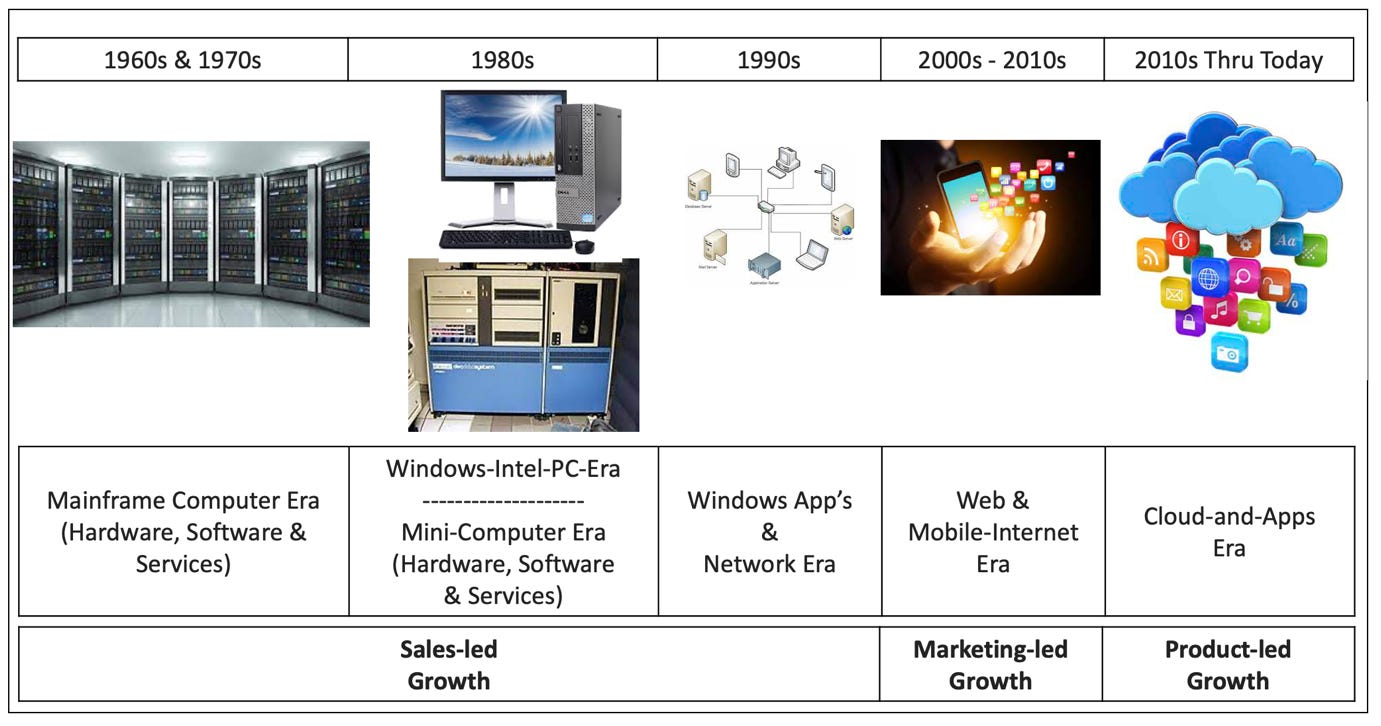The current passion for product-led growth (PLG) can be traced back to successful PLG companies such as Atlassian, Datadog, Dropbox, LogMeIn, Slack, and Zendesk – just to name a few. They are enjoying fast growth, marketing efficiencies, end-user influenced product line enhancements and extensions, and active user communities, all of which combine to generate dazzling financial results and quite a bit of jealousy.
This passion means that PLG has supplanted sales-led and marketing-led growth as the thing to do for startups everywhere. But it’s not merely a fad. There's a straight line that connects the decline of the enterprise software sales and marketing model, the adoption of lean startup concepts - such as MVP and more recently MVC - and the continuing evolution of technology as reasons that have contributed to us heading on the PLG-path.
For those who haven’t lived through it (as I have), allow me to offer some historical context. The era of mainframe and mini-computer hardware, software and services extended all the way from the 1960s through the ‘70s-and into the ‘80s. The Windows-Intel-PC era followed in the 1980s and the Windows Apps and Network Era followed in the 1990s. This period from the 1960’s through 1990s was the "sales-led growth" era. The Web era in the 2000's and the Mobile-Internet in 2010+ were "marketing-led growth" eras. Those were followed in the 2010’s through today with the Cloud-and-App Era – also known as the End-User Era. It looks like this on a timeline and graphically:
Today the end-user is the center of the enterprise software purchasing power dynamic. End-users demand that software provides:
Better data access
Easy user interfaces (UI)
Better presentation capabilities
Easy leveraging of algorithms
Direct utilization of favored apps and low-code tools, and
Easy access to other systems via APIs.
In order to achieve commercial success in today's enterprise market, technology companies must build products that meet end users’ requirements and preferences. In fact, products not only need to reflect users’ needs, they need to be based on input derived from direct engagements with, and subsequent conversion of, those same end users.
12 Keys to PLG Success
This simple to understand but hard to put into practice PLG imperative is fortified by the following 12 keys to PLG success:
If you don’t already utilize the PLG model, make it your new company mission, ingrain it in your corporate culture and align all departments around that vision. Develop and deploy a custom PLG Playbook.
Hire product managers, sales and marketing personnel who are committed to the PLG vision
Leverage your MVPs with end users during the early stages of your company.
Design products in conjunction with end users. Consider PLG to be a more comprehensive and deeper involvement with end users that is centered around product development.
Transform the messaging on your website and position your company as being PLG-centric.
Schedule and hold regular (in-person) meetings with end users. Use the company-by-company approach at first; then consider doing a vertical industry approach.
Consider creating a national PLG/end user event online.
Create a deep and abiding on-line end user community – ideally by creating an MVC.
Deliver value to the end user before capturing value – i.e., invoicing them.
Build products with the intent of selling to the most demanding, exacting and most communicative end users.
Use a free complete demo version, ‘freemium’ or, preferably, open source software approach to achieve post-build end user engagement.
Use a bottom-up distribution model – ideally including a ‘coin-operated’, self-service company website – to facilitate customers’ purchases.
The overarching goal of these 12 keys is to improve user experiences and increase go-to-market (read marketing and sales) efficiency.
Undeniable Direction with Momentum – So Join the Fun!
In many ways, the panorama of computing history has been one long march toward greater ‘democratization’ of technology. In the old mainframe days, only a few white-shirted engineers were allowed in ‘the computer room’. How things have changed. In today’s Cloud & App era, citizen developers (end users) are directly impacting product directions. In other words, technology has moved inexorably from the hands of the few into the hands of many.
The PLG movement is the latest chapter in this marvelous story. It’s a story that will continue to unfold in this direction for the foreseeable future. At the mega-successful companies that I mentioned at the top of this post, and at more and more startups that are emulating them, end users are co-piloting product development. If you want to win like those companies are, perhaps it’s time you gave your company’s end users more time at the product development controls. Chances are, they’ll fly just fine!




